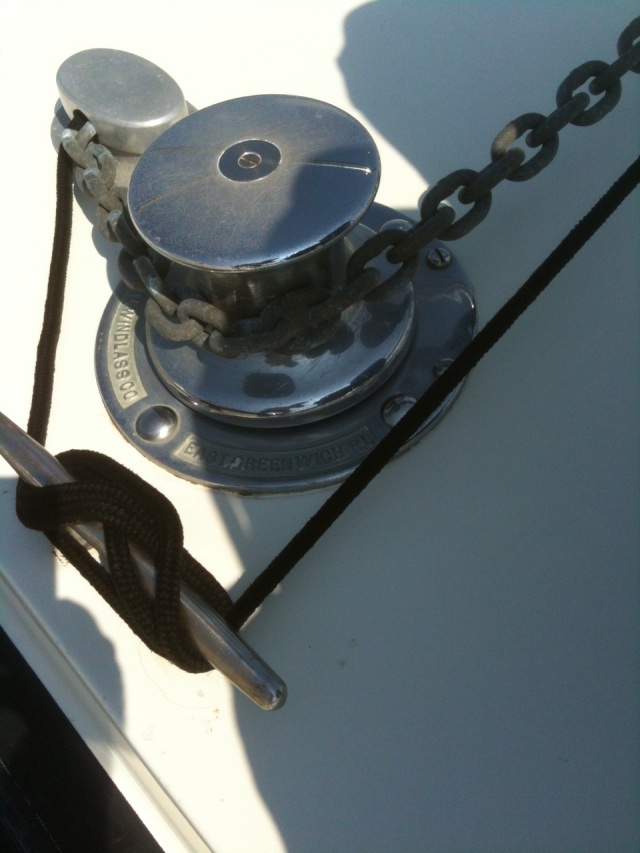The windlass is the doohickie on the bow that’s used to lower and raise the anchor. Yes, gravity will do a fine job of lowering it, but then the anchor and chain usually ends up in a big pile on the bottom, and that’s not good.
Our original windlass was a power-up-only model, and it was set up to only pull rope, not chain. We have a combination of rope and chain, and I wanted some mechanical assistance raising the anchor, so the original windlass had to go.
I did lots of research on Al Gore’s interwebs, and determined that I wanted an RC 12-10 made by Maxwell out of New Zealand (same place as where the twist-tie study was performed).
From my research, it looked like replacing the windlass would be as easy as 1, 2, 3.
1: Remove the old windlass.
2: Prepare the deck and wiring for the new windlass.
3: Install the new windlass.
My shiny new windlass arrived via FedEx, and I got right to work, assuming I’d be done in a few days. Boy, was I wrong. I am just now nearing completion, after a couple months of work in Florida’s balmy weather.
Today, I’m going to detail step 1, and I’ll explain steps 2 and 3 in future posts.
First, this is what the old windlass looked like.
The round part on top is called a capstan, and an electric motor under the deck makes it turn. When you want to pull the anchor, you wrap the anchor line around the capstan a couple times, keep some tension on it, and engage the motor.
Capstan turns, rope gets pulled aboard, anchor follows. Simple.
Except remember, we use a rope to which 40 feet of 3/8″ chain is spliced, and the capstan does not like to pull chain. You can see in this picture, that the capstan has no “teeth” to grab the chain, and taking wraps of chain will do nothing but chew up the capstan. So, out it comes.
The old windlass was made by a company named Ideal. They have a website that provides instructions for removing this particular windlass. The instructions are not particularly encouraging. In part, the instructions mention that it may be necessary to use methods just short of C4 explosives (yes, they really say that) to get the old windlass out.
The problem is, the old windlass has a 2″ diameter shaft that sticks up through the deck. Over the years, this steel shaft gets corroded and expands, and literally locks itself into the hole in the deck. By one means or another, one must get the shaft and the attached gearbox, altogether weighing about 60 pounds, to drop down out of the hole in the deck, without falling all the way to the bottom of the boat. With a helper to hold it from below, this is not too difficult, but I was doing this solo, so I had to be a bit more creative.
I tapped on the top of the shaft, then I pounded, then I got a grinder out and ground away part of the flat plate that goes around the shaft, then I pounded some more, this time assisted by a liberal application of nautical expletives, and then finally it was to a point where I thought it would come free.
I didn’t want it to just free fall, so I rigged up a Rube Goldberg device to help me control its descent.
A few more taps (with a 3 pound sledge) and it came free of the hole and was hanging by the chain. I needed to drop it down onto the board that’s laying in the hole at the top of this photo, then bring it out of the hole and set it on a little table I set up, so I could then lift it out of the anchor locker onto the deck.
The whole process left the deck plate a little worse for the wear…
 But I finally got that sucker up on deck. First time it’s seen daylight in about 24 years.
But I finally got that sucker up on deck. First time it’s seen daylight in about 24 years.
 A close-up of the top of the shaft shows what happened. I pounded on it so hard, that I actually mushroomed the top of the shaft, which of course made it a tighter fit in the hole, necessitating increasingly vigorous pounding, etc., etc.
A close-up of the top of the shaft shows what happened. I pounded on it so hard, that I actually mushroomed the top of the shaft, which of course made it a tighter fit in the hole, necessitating increasingly vigorous pounding, etc., etc.
Once it was out, the holes that were left in the deck were conveniently arranged so that none were the right size or location to be of use when installing the new windlass. Time to mix up some epoxy and fill the old holes, and start planning to drill the new ones.
More on that later.





